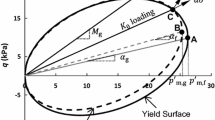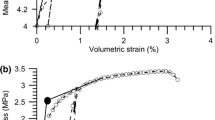Abstract
An exploratory discussion is presented on the application of egg-shaped function in elasto-plastic constitutive analysis for soft clay. Two main tasks of the paper are: 1) to propose a complete yield criterion based on egg-shaped function and supplement its definition in the deviatoric section, and then a yield criterion suitable for 3D stress conditions is obtained; 2) to elaborate its numerical implementation based on the drained triaxial tests. During the above discussion, a non-associated flow rule is proposed, in which the stress-dilatancy relationship in most classical theory is replaced by a linear dependence between the stress state parameter η and the rotation angle η of the plastic potential surface. Thereafter, isotropic and kinematic hardening behavior is considered by employing the hardening parameter H, which can be expressed as the function of plastic work Wp. Finally, comparisons between numerical results and test data on Taizhou soft clay are made to verify the effectiveness of the proposed model.
摘要
本文针对蛋形函数在软黏土弹塑性本构分析中的应用进行了讨论。两项主要的研究任务分别为: 1) 以蛋形函数为基础,提出完整的蛋形屈服理论,补充其在偏平面中的定义,得出三维应力条件下 的强度屈服准则;2) 具体阐述蛋形本构模型的数值实现方法。首先,根据排水三轴试验结果,提出 一种非关联塑性流动法则,其中大多数经典本构理论中的应力-剪胀关系被归一化应力状态参数η 与 塑性势面旋转角γ 之间的线性关系所代替。进一步,通过采用硬化参数H (H 可以表示为塑性功Wp 的 函数)来表征土体等向以及运动硬化行为。最后,将蛋形模型的数值计算结果与台州软土试验数据进 行对比,验证了本文模型的有效性。
Similar content being viewed by others
References
ROSCOE K H, BURLAND J B. On the generalised stress-strain behaviour of ‘wet’ clay [C]// HEYMAN J, LECKIE F A. Engineering Plasticity. Cambridge University Press, 1968: 535–609. DOI: https://doi.org/10.1016/0022-4898(70)90160-6.
MCDOWELL G R, HAU K W. A generalised modified Cam clay model for clay and sand incorporating kinematic hardening and bounding surface plasticity [J]. Granular Matter, 2004, 6(1): 11–16. DOI: https://doi.org/10.1007/s10035-003-0152-8.
DAFALIAS Y F, MANZARI M T, PAPADIMITRIOU A G. SANICLAY: Simple anisotropic clay plasticity model [J]. International Journal for Numerical and Analytical Methods in Geomechanics, 2006, 30(12): 1231–1257. DOI: https://doi.org/10.1002/nag.524.
YAO Yang-ping, HOU Wei, ZHOU An-nan. UH model: Three-dimensional unified hardening model for overconsolidated clays [J]. Géotechnique, 2009, 59(5): 452–469. DOI: https://doi.org/10.1680/geot.2007.00029.
YAN W M, LI X S. A model for natural soil with bonds [J]. Géotechnique, 2011, 61(2): 95–106. DOI: https://doi.org/10.1680/geot.8.p.061.
YIN Zhen-yu, XU Qiang, HICHER P Y. A simple critical-state-based double-yield-surface model for clay behavior under complex loading [J]. Acta Geotechnica, 2013, 8(5): 509–523. DOI: https://doi.org/10.1007/s11440-013-0206-y.
ZHONG Zhi-hui, YANG Guang-hua, FU Xu-dong, WEN Yong, ZHANG Yu-cheng. Numerical verification of similar Cam-clay model based on generalized potential theory [J]. Journal of Central South University, 2014, 21(12): 4707–4713. DOI: https://doi.org/10.1007/s11771-014-2480-8.
JOCKOVIC S, VUKICEVIC M. Bounding surface model for overconsolidated clays with new state parameter formulation of hardening rule [J]. Computers and Geotechnics, 2017, 83: 16–29. DOI: https://doi.org/10.1016/j.compgeo.2016.10.013.
HAN J, LIANG H, CAO C, BI Z, ZHU Z. A mechanical model for sheared joints based on Mohr-Coulomb material properties [J]. Géotechnique Letters, 2018, 8(2): 92–96. DOI: https://doi.org/10.1680/jgele.17.00106.
YAO Yang-ping, LIU Lin, LUO Ting, TIAN Yu, ZHANG Jian-min. Unified hardening (UH) model for clays and sands [J]. Computers and Geotechnics, 2019, 110: 326–343. DOI: https://doi.org/10.1016/j.compgeo.2019.02.024.
YIN Zhen-yu, CHANG C S, KARSTUNEN M, HICHER P Y. An anisotropic elastic-viscoplastic model for soft clays [J] International Journal of Solids and Structures, 2010, 47(5): 665–677. DOI: https://doi.org/10.1016/j.ijsolstr.2009.11.004.
HAMMI Y, STONE T W, PALIWAL B, HORSTEMEYER M F, ALLISON P G. Smooth yield surface constitutive modeling for granular materials [J]. ASME Journal of Engineering Materials and Technology, 2017, 139(1): 011010. DOI: https://doi.org/10.1115/1.4034987.
UEDA K, LAI S. Constitutive modeling of inherent anisotropy in a strain space multiple mechanism model for granular materials [J]. International Journal for Numerical and Analytical Methods in Geomechanics, 2019, 43(3): 708–737. DOI: https://doi.org/10.1002/nag.2883.
JIANG Ming-jing. New paradigm for modern soil mechanics: Geomechanics from micro to macro [J]. Chinese Journal of Geotechnical Engineering, 2019, 41(2): 195–254. DOI: https://doi.org/10.11779/CJGE201902001. (in Chinese)
ZENG Tao, SHAO Jian-fu, YAO Yao. A micromechanical-based elasto-viscoplastic model for the Callovo-Oxfordian argillite: Algorithms, validations, and applications [J]. International Journal for Numerical and Analytical Methods in Geomechanics, 2020, 44(2): 183–207. DOI: https://doi.org/10.1002/nag.3006.
PETALAS A L, DAFALIAS Y F, PAPADIMITRIOU A G. SANISAND-F: Sand constitutive model with evolving fabric anisotropy [J]. International Journal of Solids and Structures, 2020, 188–189: 12–31. DOI: https://doi.org/10.1016/j.ijsolstr.2019.09.005.
JIANG Ming-jing, YU Hai-sui, LEROUEIL S. A simple and effcient approach to capturing bonding effect in naturally microstrucutred sands by discrete element method [J]. International Journal for Numerical Methods in Engineering, 2007, 69(6): 1158–1193. DOI: https://doi.org/10.1002/nme.1804.
YIN Zhen-yu, CHANG C S. Microstructural modelling of stress-dependent behaviour of clay [J]. International Journal of Solids and Structures, 2009, 46(6): 1373–1388. DOI: https://doi.org/10.1016/j.ijsolstr.2008.11.006.
YIN Zhen-yu, HATTAB M, HICHER P Y. Multiscale modeling of a sensitive marine clay [J]. International Journal for Numerical and Analytical Methods in Geomechanics, 2011, 35(15): 1682–1702. DOI: https://doi.org/10.1002/nag.977.
YAO Yang-ping, LU De-chun, ZHOU An-nan, ZOU Bo. Generalized non-linear strength theory and transformed stress space [J]. Science in China, Series E: Technological Sciences, 2004, 47(6): 691–709. DOI: https://doi.org/10.1360/04ye0199.
MATSUOKA H, NAKAI T. Stress-deformation and strength characteristics of soil under three different principal stresses [J]. Proceedings of the Japan Society of Civil Engineers, 1974, 232: 59–70. DOI: https://doi.org/10.2208/jscej1969.1974.232_59.
NAKAI T, MATSUOKA H. A generalised elastoplastic constitutive model for clay in three dimensional stresses [J]. Soils and Foundations, 1986, 26(4): 81–98. DOI: https://doi.org/10.3208/sandf1972.26.3_81.
MITSUTOSHI Y. 3-D Coulomb’s failure criterion for various geomaterials [C]// LADE P V, NAKAI T. Geomechanics II: Testing, Modeling, and Simulation, ASCE. Resyon, VA, 2005: 71–86. DOI: https://doi.org/10.1061/40870(216)6.
NAKAI T, HINOKIO M. A simple elastoplastic model for normally and over consolidated soils with unified material parameters [J]. Soils and Foundations, 2004, 44(2): 53–70. DOI: https://doi.org/10.3208/sandf.44.2_53.
MORTARA G. A new yield and failure criterion for geomaterials [J]. Géotechnique, 2008, 58(2): 125–132. DOI: https://doi.org/10.1680/geot.2008.58.2.125.
MORTARA G. A hierarchical single yield surface for frictional materials [J]. Computers and Geotechnics, 2009, 36(6): 960–967. DOI: https://doi.org/10.1016/j.compgeo.2009.03.007.
MORTARA G. A constitutive framework for the elastoplastic modelling of geomaterials [J]. International Journal of Solids and Structures, 2015, 63: 139–152. DOI: https://doi.org/10.1016/j.ijsolstr.2015.02.047.
LU De-chun, MA Chao, DU Xiu-li, JIN Liu, GONG Qiu-ming. Development of a new nonlinear unified strength theory for geomaterials based on thr characteristic stress concept [J]. International Journal of Geomechanics, ASCE, 2017, 17(2): 4016058. DOI: https://doi.org/10.1061/(asce)gm.1943-5622.0000729.
BARDET J P. Lode dependences for isotropic pressure-sensitive elastoplastic materials [J]. ASME Journal of Applied Mechanics, 1990, 57(3): 498–506. DOI: https://doi.org/10.1115/1.2897051.
SHAO J F, ZHU Q Z, SU K. Modeling of creep in rock materials in terms of material degradation [J]. Computers and Geotechnics, 2003, 30(7): 549–555. DOI: https://doi.org/10.1016/s0266-352x(03)00063-6.
LAGIOIA R, PANTEGHINI A. On the existence of a unique class of yield and failure criteria comprising Tresca, Von-Mises, Drucker-Prager, Mohr-Coulomb, Galileo-Rankine, Matsuoka-Nakai and Lade-Duncan [J]. Proceedings of the Royal Society A: Mathematical, Physical and Engineering Science, 2016, 472(2185): 20150713. DOI: https://doi.org/10.1098/rspa.2015.0713.
JIANG Hua. Three-dimensional failure criteria for rocks based on the Hoek-Brown criterion and a general Lode dependence [J]. International Journal of Geomechanics, 2017, 17(8): 04017023. DOI: https://doi.org/10.1061/(asce)gm.1943-5622.0000900.
YAO Yang-ping, WANG Nai-dong. Transformed stress method for generalizing soil constitutive models [J]. ASCE Journal of Engineering Mechanics, 2014, 140(3): 614–629. DOI: https://doi.org/10.1061/(asce)em.1943-7889.0000685.
LU De-chun, LI Xiao-qiang, DU Xiu-li, LIANG Jing-yu. A simple 3D elastoplastic constitutive model for soils based on the characteristic stress [J]. Computers and Geotechnics, 2019, 109: 229–247. DOI: https://doi.org/10.1016/j.compgeo.2019.02.001.
CHEN Hao-hua, LI Lin, LI Jiang-pei, WANG Hui. Stress transform method to undrained and drained expansion of a cylindrical cavity in anisotropic modified cam-clay soils [J]. Computers and Geotechnics, 2019, 106: 128–142. DOI: https://doi.org/10.1016/j.compgeo.2018.10.016.
WAN Zheng, SONG Chen-chen, MENG Da. A nonlinear strength criterion and transformation stress method [J]. Chinese Journal of Theoretical and Applied Mechanics, 2019, 51(4): 1210–1222. DOI: https://doi.org/10.6052/0459-1879-19-039. (in Chinese)
REN Fang, SHENG Qian, CHANG Yan-ting. Egg-shaped yield function for geotechnical engineering materials [J]. Chinese Journal of Geotechnical Engineering, 1993, 13(4): 33–39. DOI: https://doi.org/10.3321/j.issn:1000-4548.1993.04.005. (in Chinese)
XU Ri-qing, YANG Lin-de, GONG Xiao-nan. Stress-strain constitutive relationship of boundary surface of soils [J]. Jounal of Tongji University (Nature & Science), 1997, 25(1): 29–33. (in Chinese)
XU Ri-qing, WANG Xing-chen, RONG Xue-ning. Marco- and meso-scale parametric analysis of egg-shaped yield surface of structural soil [J]. International Journal of Offshore and Polar Engineering, 2014, 24(4): 301–308.
ZIENKIEWICZ O C, PANDE G N. Some useful forms of isotropic yield surfaces for soil and rock mechanics [C]//GUDEHUS G. Finite Element in Geomechanics. London: John Wiley & Sons Ltd, 1977: 179–190.
YU H S. CASM: A unified state parameter model for clay and sand [J]. International Journal for Numerical and Analytical Methods in Geomechanics, 1998, 22(8): 621–653. DOI: https://doi.org/10.1002/(sici)1096-9853(199808)22:8<621::aid-nag937>3.0.co;2-8.
PANTEGHINI A, LAGIOIA R. An extended modified Cam-Clay yield surface for arbitrary meridional and deviatoric shapes retaining full convexity and double homothety [J]. Géotechnique, 2018, 68(7): 590–601. DOI: https://doi.org/10.1680/jgeot.17.p.016.
ARGYRIS J H, FAUST G, SZIMMAT J, WARNKE E P, WILLAM K J. Recent developments in the finite element analysis of prestressed concrete reactor vessels [J]. Nuclear Engineering and Design, 1974, 28(1): 42–75. DOI: https://doi.org/10.1016/0029-5493(74)90088-0.
WILLAM K, WARNKE E P. Constitutive model for the triaxial behavior of concrete [C]// Seminar on Concrete Structure Subjected to Triaxial Stresses, ISMES. Bergamo, Italy, 1975: 17–19. DOI: https://doi.org/10.5169/seals-17526.
van EEKELEN H A M. Isotropic yield surface in three dimensions for use in soil mechanics [J]. International Journal for Numerical and Analytical Methods in Geomechanics, 1980, 4(1): 89–101. DOI: https://doi.org/10.1002/nag.1610040107.
LIN Feng-bao, BAZANT Z P. Convexity of smooth yield surface of frictional material [J]. ASCE Journal of Engineering Mechanics, 1986, 112(11): 1259–1262. DOI: https://doi.org/10.1061/(asce)0733-9399(1986)112:11(1259).
SHENG D, SLOAN S W, YU H S. Aspects of finite element implementation of critical state models [J]. Computational Mechanics, 2000, 26(2): 185–196. DOI: https://doi.org/10.1007/s004660000166.
HASHIGUCHI K. A proposal of the simplest convex-conical surface for soils [J]. Soils and Foundations, 2002, 42(3): 107–113. DOI: https://doi.org/10.3208/sandf.42.3_107.
GUO Rui-ping, LI Guang-xin. Elasto-plastic model of soil with a function of plastic work as the hardening function [J]. Journal of Tsinghua University (Science and Technology), 2000, 40(5): 125–127. DOI: https://doi.org/10.16511/j.cnki.qhdxxb.2000.05.034. (in Chinese)
LIU Xin-rong, ZHONG Zu-liang, ZHANG Yong-xing, WANG Ji-ming. Elastoplastic modeling of unsaturated intact Q2 loess with plastic work as hardening parameter [J]. Rock and Soil Mechanics, 2009, 30(5): 1215–1220. DOI: https://doi.org/10.16285/j.rsm.2009.05.028. (in Chinese)
ROSCOE K H, POOROOSHASB H B. A theoretical and experimental study of strains in triaxial tests on normally consolidated clays [J]. Géotechnique, 1963, 13(1): 12–38. DOI: https://doi.org/10.1016/0022-4898(64)90162-4.
POOROOSHASB H B, HOLUBEC I, SHERBOURNE A N. Yielding and flow of sand in triaxial compression: Part I [J]. Canadian Geotechnical Journal, 1966, 3(4): 179–190. DOI: https://doi.org/10.1139/t66-023.
LADE P V, DUNCAN J M. Stress-path dependent behavior of cohesionless soil [J]. ASCE Journal of Geotechnical Engineering, 1976, 102(1): 51–68.
ZHOU Cheng, LEROUEIL S, FAFARD M, GHORBEL S. Constitutive modeling of kinematic hardening behavior of saturated anisotropic soils [J]. ASCE International Journal of Geomechanics, 2017, 17(3): 04016063. DOI: https://doi.org/10.1061/(asce)gm.1943-5622.0000732.
HUANG Wen-xi. Theory of elastoplastic stress-strain model for soil [J]. Rock and Soil Mechanics, 1979, 1(1): 1–20. DOI: https://doi.org/10.16285/j.rsm.1979.01.002. (in Chinese)
SULTAN N, CUI Y J, DELAGE P. Yielding and plastic behavior of Boom clay [J]. Géotechnique, 2010, 60 (9): 657–666. DOI: https://doi.org/10.1680/geot7.00142.
SCHOFIELD A N, WORTH C P. Critical state soil mechanics [M]. New York: McGraw-Hill, 1968.
JIN Yin-fu, YIN Zhen-yu, SHEN Shui-long, HICHER P Y. Investigation into MOGA for identifying parameters of a critical-state-based sand model and parameters correlation by factor analysis [J]. Acta Geotechnica, 2016, 11(5): 1311–1145. DOI: https://doi.org/10.1007/s11440-015-0425-5.
JIN Yin-fu, WU Ze-xiang, YIN Zhen-yu, SHEN Shui-long. Estimation of critical state-related formula in advanced constitutive modeling of granular material [J]. Acta Geotechnica, 2017, 12(6): 1329–1351. DOI: https://doi.org/10.1007/s11440-017-0586-5.
Author information
Authors and Affiliations
Corresponding author
Additional information
Foundation item: Project(41672264) supported by the National Natural Science Foundation of China; Project (2019C03103) supported by the Key Research and Development Program of Zhejiang Province, China
Rights and permissions
About this article
Cite this article
Jiang, Jq., Xu, Rq., Yu, Jl. et al. A practical constitutive theory based on egg-shaped function in elasto-plastic modeling for soft clay. J. Cent. South Univ. 27, 2424–2439 (2020). https://doi.org/10.1007/s11771-020-4459-y
Received:
Accepted:
Published:
Issue Date:
DOI: https://doi.org/10.1007/s11771-020-4459-y




